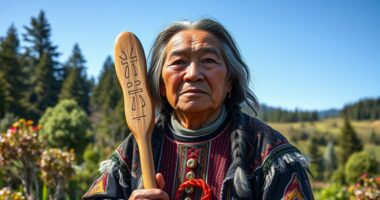Language shapes how you see and connect with the environment by embedding words for countries, seasons, and animals that carry deep ecological meaning. Indigenous terms often describe behaviors, roles, and cultural practices linked to nature, offering insights that many modern languages lack. When these words are lost, so is essential ecological knowledge and cultural heritage. To uncover how language reflects and influences our relationship with the land, keep exploring this fascinating connection further.
Key Takeaways
- Indigenous languages contain unique terms that describe landscapes, seasons, animals, and plants, reflecting deep ecological knowledge.
- These words encode cultural practices and behavioral insights of species, enriching environmental understanding.
- Loss of indigenous language results in diminished ecological vocabulary, threatening biodiversity and sustainable land management.
- Language preservation maintains cultural and ecological connections, fostering responsible stewardship of natural environments.
- Protecting linguistic diversity helps sustain ecological wisdom and supports global efforts toward environmental resilience.

Have you ever considered how the words we choose shape our relationship with the environment? The language we speak influences how we perceive, interact with, and value the natural world. When it comes to Indigenous language preservation, this becomes especially clear. Many Indigenous languages contain unique terms for local landscapes, seasons, animals, and plants—words that often lack direct translations in dominant languages. These terms embody deep ecological knowledge, reflecting centuries of living in harmony with the land. Losing an Indigenous language means losing this rich vocabulary, along with essential insights about sustainable practices and ecological relationships. The erosion of linguistic diversity threatens not only cultural heritage but also the ecological wisdom embedded within these languages, which is fundamental for understanding and protecting biodiversity.
Losing Indigenous languages means losing vital ecological knowledge and cultural heritage essential for biodiversity and sustainability.
Linguistic diversity and ecology are interconnected; each language offers a different lens through which to view the environment. When a language disappears, we lose more than words—we lose a way of understanding the natural world. Indigenous languages often have specific terms for local environments and species, capturing their behaviors, roles, and significance within a community. These words carry meaning that goes beyond mere labels; they encode cultural practices and ecological knowledge passed down through generations. For example, a single word in an Indigenous language might describe a specific seasonal change, a particular animal’s behavior, or a traditional use of a plant—knowledge that can inform conservation efforts today. Preserving this linguistic diversity is essential because it enriches our collective understanding of ecology and highlights sustainable ways to coexist with nature.
Furthermore, recognizing the value of Indigenous languages promotes a broader appreciation for ecological stewardship rooted in cultural wisdom. When you support efforts to safeguard these languages, you’re also helping maintain the biodiversity they help describe and sustain. Indigenous communities often view their language as a living document that keeps their connection to the land alive. This connection fosters environmental responsibility and sustainable living practices. As global environmental challenges intensify, integrating Indigenous ecological knowledge through language preservation becomes increasingly important. It offers alternative perspectives and practices that can complement scientific approaches, ultimately fostering more holistic and effective environmental solutions.
In essence, the words for country, seasons, and animals within Indigenous languages serve as essential links to ecological understanding. By valuing and protecting linguistic diversity, you help preserve the cultural and ecological tapestries that sustain our planet. These languages embody centuries of sustainable interaction with nature, reminding us that how we speak about the environment influences how we treat it. Embracing linguistic diversity isn’t just about language; it’s about safeguarding the wisdom needed to guarantee a resilient and thriving Earth for generations to come.
A deeper understanding of linguistic diversity can guide us towards more sustainable relationships with our environment and inspire innovative conservation strategies.
Frequently Asked Questions
How Do Environmental Changes Influence Indigenous Vocabulary?
Environmental changes directly impact indigenous vocabulary by threatening cultural resilience and linguistic diversity. As ecosystems shift, your community adapts by developing new words for altered landscapes, animals, and seasons. These linguistic changes reflect your connection to the environment and help preserve cultural identity. You might find that some traditional terms fade, but new words emerge, ensuring your language remains vibrant and relevant within a changing world.
Are There Universal Words for Seasons Across Cultures?
You might wonder if universal words for seasons exist across cultures. While some symbols like spring, summer, fall, and winter carry shared meanings, linguistic diversity shapes unique seasonal terms rooted in cultural symbolism. These words reflect how different societies perceive nature’s cycles. Although commonalities exist, the diversity of language reveals that no single set of words captures the full depth of seasonal change worldwide.
How Do Animals Feature in Environmental Storytelling?
Animals play a essential role in environmental storytelling by symbolizing seasonal changes and migration patterns. You can see this in stories where animal migration marks the arrival of seasons, guiding community activities. Habitat naming also highlights animals’ importance, reflecting their connection to specific environments. These narratives help you understand local ecosystems and cultural values, emphasizing how animals anchor stories about the land, seasons, and the natural world.
What Role Does Language Play in Conservation Efforts?
Language acts as a bridge, transforming words into powerful tools for conservation. Your use of linguistic diversity sparks ecological awareness, making people see nature through fresh eyes. When you preserve and promote diverse languages, you’re safeguarding cultural and environmental heritage alike. Your voice can inspire action, turning community stories into rallying cries for change. Ultimately, language shapes understanding, guiding efforts to protect our planet’s fragile ecosystems and the rich tapestry of life they support.
How Do Language Shifts Affect Environmental Knowledge Preservation?
Language shifts can weaken environmental awareness because they threaten linguistic identity, which is tied to traditional ecological knowledge. As languages fade, you risk losing unique terms for local seasons, animals, and landscapes that carry essential conservation information. When communities switch to dominant languages, this knowledge may become inaccessible or forgotten. Protecting linguistic diversity helps preserve environmental knowledge, ensuring future generations understand and value their natural surroundings.
Conclusion
You realize that over 7,000 languages worldwide name countries, seasons, and animals, highlighting how language reflects our environment. This vast diversity shows just how deeply intertwined our words are with nature. When you learn the names for local animals or seasons, you connect more meaningfully to the world around you. Preserving these languages helps protect not only culture but also the environment itself, reminding us that language and nature are truly inseparable.
Mary is a passionate writer who brings creativity and a fresh perspective to our team. Her words have the power to captivate and inspire, making her an essential contributor to our content. Mary’s commitment to storytelling and dedication to promoting Indigenous culture ensures that her work touches the hearts of our readers. We’re fortunate to have her as part of our team.










